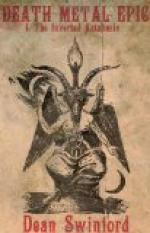Guinevere—her sin having been discovered by her hitherto fabulously blind husband—took refuge in a nunnery at Almesbury, where she received a farewell visit from Arthur and an assurance of his forgiveness, before he rode into his last fight.
As for Launcelot, he, too, devoted his last days to penance and prayer in a monastery. There he remained until warned in a vision that Guinevere was dead. Leaving his cell, Launcelot hastened to Almesbury, where, finding Guinevere had ceased to breathe, he bore her corpse to Glastonbury—where according to some versions Arthur had been conveyed by the barge and buried—and there laid her to rest at her husband’s feet.
Then Launcelot again withdrew to his cell, where he died after six months’ abstinence and prayer. It was his heir, Sir Ector, who feelingly pronounced the eulogy of the knight par excellence of the mediaeval legends in the following terms: “‘Ah, Sir Lancelot,’ he said, ‘thou were head of all Christian knights; and now I dare say,’ said Sir Ector, ’that, Sir Lancelot, there thou liest, thou were never matched of none earthly knight’s hands; and thou were the courtliest knight that ever bare shield; and thou were the truest friend to thy lover that ever bestrode horse; and thou were the truest lover of a sinful man that ever loved woman; and thou were the kindest man that ever struck with sword; and thou were the goodliest person that ever came among press of knights; and thou were the meekest man, and the gentlest, that ever ate in hall among ladies; and thou were the sternest knight to thy mortal foe that ever put spear in rest.’”
FOOTNOTES:
[Footnote 23: See, the author’s “Stories of the Wagner Operas.”]
ROBIN HOOD
Among the most popular of the prose epics is the story of Robin Hood, compiled from some twoscore old English ballads, some of which date back at least to 1400. This material has recently been charmingly reworked by Howard Pyle, who has happily illustrated his own book. The bare outline of the tale is as follows:




